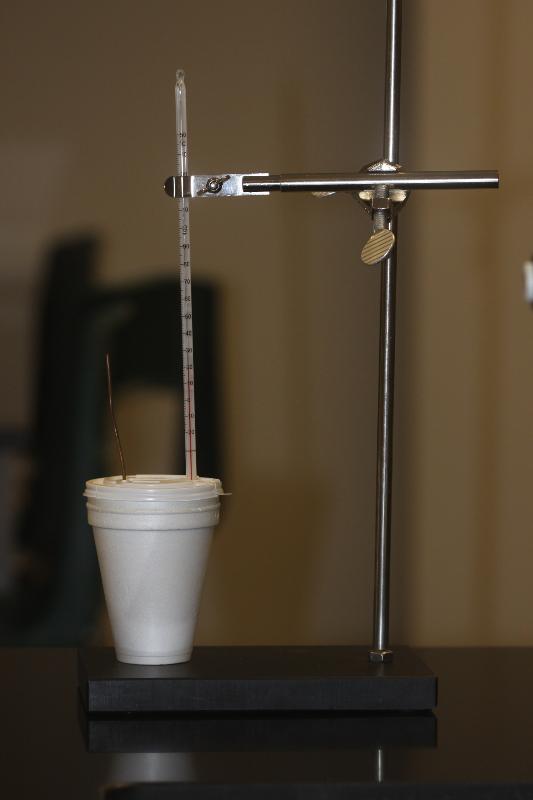- Enthalpy is a state variable defined as H=U+PV.
- Under constant pressure conditions, the change in enthalpy is equal to the heat flow (ΔH=qp).
- A coffee cup calorimeter can be used to measure heat flow at constant pressure.
- If ΔH>0, the process is endothermic.
- If ΔH<0, the process is exothermic.
In the previous section, we discussed constant volume calorimetry, where systems (reactions) cannot exchange any energy in the form of PV-work with the surroundings. In the laboratory, however, most reactions are carried out under constant pressure conditions (i.e. under atmospheric pressure).
If the volume is not kept constant, the change in the internal energy (ΔU) is harder to measure because the work is no longer zero; both heat and work would have to be measured. This can be done, and the change in internal energy (ΔU) can still be quantified for processes where the volume changes. For processes where the pressure is constant, ΔU is not as insightful as the change in the new state variable we are about to introduce: enthalpy (H).
Enthalpy is another measure of the energy within a system. It is a state variable that is defined as the internal energy (E or U) plus the product of the pressure with the volume: H = U + PV. This definition applies to a thermodynamic state (i.e a state has some quantity of enthalpy, just like it has a temperature). It is important to be able to differentiate between enthalpy (H) as an absolute amount, and a change in enthalpy (ΔH). Changes in enthalpy (ΔH) are fundamentally important for describing processes. Just like all other state variables, we quantify the change in enthalpy as ΔH = Hfinal – Hinitial = Hf – Hi.
There are three possible cases when discussing changes in enthalpy: it can stay the same, decrease, or increase. Because enthalpy is a state function, the path (process) taken to go from the initial state to the final state does not matter. The following possibilities apply to all types of processes.
Case 1: ΔH = 0
If the process results in no net change in enthalpy, then ΔH = 0. This case is rare for chemical reactions, with the exception of “null reactions” such as O2(g) → O2(g), where nothing happens (the state of the system does not change) and ΔH must be zero. In CHEM 123, there is one common case where ΔH = 0. A sample of n moles of ideal gas will have ΔH = 0 if it undergoes a constant temperature process. (Note: ΔU is also zero in this case).
Case 2: ΔH < 0
If the process results in a decrease in enthalpy, then the enthalpy of the final state is lower than that of the initial state. Enthalpy is a type of energy, so if ΔH < 0, then the system gives off energy to the surroundings. The process is exothermic (expels heat).
Case 3: ΔH > 0
If the process results in an increase in enthalpy, then the system has absorbed energy from the surroundings. The process is endothermic (absorbs heat).
The change in enthalpy, like the change in internal energy, is easier to measure if we only have to measure heat flow, rather than both heat and work. Starting from the definition of enthalpy, below we will show that under the conditions of constant pressure we can measure ΔH using heat flow only. The heat flow (a path variable) for a particular path gives the change in a state variable (ΔH).
Enthalpy is defined as
This definition is always true. The change in enthalpy is given by ΔH=Hf – Hi. If we use the definition of enthalpy given above for the initial state and the final state, we can write that the overall change in enthalpy is equal to the change in internal energy plus the change in PV (pressure times volume):
For a constant pressure process, there is no change in P, so we can write
We can use the first law of thermodynamics (ΔU = q + w) to replace ΔU:
and substitute in the definition of work at constant pressure (w = –PextΔV)
For a constant pressure process, Pext (the external pressure) will equal P (the pressure of the system) so we have:
Cancelling the PΔV terms leaves us with
which only applies at constant pressure (the subscript “P” on the q is to remind us that this is only true for constant pressure processes).
In this section, we’ve outlined a method to find ΔH by measuring heat flow under constant pressure conditions. The easiest way to achieve constant pressure conditions is to have a calorimeter that is insulated (to retain heat), but also open to the atmosphere to maintain the pressure. The volume of the system is allowed to fluctuate, but the pressure will remain constant (in equilibrium with atmospheric pressure).
The coffee cup calorimeter is a simple example of a constant pressure calorimeter. The reaction is set up inside nested styrofoam coffee cups with a thermometer to monitor the temperature over the course of the reaction.

The temperature change in a coffee-cup calorimeter is related to the heat flow by the same formulas used for the bomb calorimeter described in Part 1, Section 1.5.